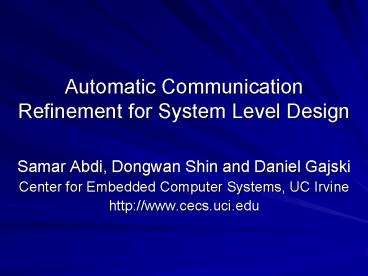Automatic Communication Refinement for System Level Design - PowerPoint PPT Presentation
1 / 15
Title:
Automatic Communication Refinement for System Level Design
Description:
SystemC Co-centric Studio (http://www.synopsys.com/products/cocentric_studio) ... Auto. Refine. Time. Modified. LOC. Comm. Model size (LOC) Transaction model ... – PowerPoint PPT presentation
Number of Views:87
Avg rating:3.0/5.0
Title: Automatic Communication Refinement for System Level Design
1
Automatic Communication Refinement for System
Level Design
- Samar Abdi, Dongwan Shin and Daniel Gajski
- Center for Embedded Computer Systems, UC Irvine
- http//www.cecs.uci.edu
2
Outline
- Main Idea
- Related work
- Introductory example
- Communication refinement
- Experimental results
- Impact on SLD
3
Possible Design Methodology
Evaluate
6.5K LOC
Specification Model
Designer Decisions
Refinement
8K LOC
Transaction model
Evaluate
Designer Decisions
Communication model
9K LOC
Evaluate
Software compilation
Interface synthesis
Hardware synthesis
Implementation model
15K LOC
4
Motivation
- Rewriting system models is painful
- Time consuming
- Error prone
- Goal Automatic model rewriting
- Extra benefits
- Speedy Design space exploration
- Choose a good communication architecture
5
Related Work
- CoWare (Symphony, DAC 1996)
- Rendezvous point to point communication with RPC
- TIMA (A. Jerraya et al. DAC 2001)
- Interface library for parameterized components
- Communication using FIFO channels
- SystemC Co-centric Studio (http//www.synopsys.com
/products/cocentric_studio) - Modeling and Simulation
- SCE (http//www.cecs.uci.edu/cad/sce.html)
- Synthesis
- Refinement
- Evaluation
6
Decisions and Refinement
Generate pin-accurate communication model from
transaction level model
- Transaction level Model
- Tasks divided amongst components.
- Point to point data
- transaction channels.
- Communication Model
- System Buses
- Bus Interfaces
- Communication structures
?
7
Communication Refinement
Designer Decisions
Protocol Library
Bus Selection
Channel Partitioning
Interrupt controller type
Arbitration policy
Arbiter
Bus 1 (protocol 1)
TC1
TC3
TC2
Bus 2 (protocol 2)
SW
HW1
HW2
SW
HW1
HW2
IC
Transaction Level Model
Communication Model
8
Transaction Channel Definition
TC
- Two way blocking communication between components
- Complex data structures
- Deterministic behavior
- Relatively independent
DATA
Send
Recv
wait
ready
ack
wait
9
Refinement Example
Added during communication refinement
System Bus Wires
ch
Interrupt
Bus Master IF
Bus Slave IF
Write words
Application Layer
Application Layer
Bit-stream gen.
Bit-stream gen.
Data Regeneration
Send (v)
v Recv( )
SW (Master)
HW (Slave)
10
Communication Style
for 2 Statically scheduled components
Master Component
Slave Component
Application Layer
Application Layer
Interrupt Handler
SlaveReady FALSE
Interrupt 0
Notify Interrupt
S1
I1
A1
BusAddress ! SlaveAddress
Interrupt 1
SlaveReady TRUE
S2
A2
I2
BusAddress SlaveAddress
SlaveReady TRUE
S3
Bus Transfer
11
Communication Style
for Dynamically scheduled master with multiple
slaves
Master Component
Slave Component
Application Layer (for variable vi)
Interrupt Handler
Application Layer
SlaveReady i FALSE
Interrupt 0
Notify Interrupt
S1
I1
A1
Interrupt 1
SlaveReady i TRUE
BusAddress ! SlaveAddress
I2
i ReadSlaveID()
S2
Reserve IOPort
A2
BusAddress SlaveAddress
SlaveReady i TRUE
I2
S3
Bus Transfer
Release IOPort
12
Complete Refinement Algorithm
- For each application channel in master
- CodeGen (wait SlaveReady)
- If (dynamic scheduling)
- CodeGen (req Bus Access)
- If (multiple masters)
- CodeGen (req Bus wait gnt)
- For each application channel in slave
- CodeGen (notify Interrupt)
- If (multiple slaves)
- CodeGen (wait gnt)
- CodeGen (notify address)
- Derive Connectivity
- Instantiate protocol channels
- Instantiate application channels
- Instantiate communication structures
- Slice data
- Add synchronization
- Master
- Slave
- Interrupt Handler
Bus
Comp
- For Each bus with numMasters gt 1
- Instantiate Arbiter
- Make req/gnt port connections
- For each master with numSlaves gt InterruptPorts
- Instantiate Interrupt Controller
- Make req/gnt port connections
- Depth first traversal over complex data structure
- For each Integral type
- Convert to bit vector
- Slices of data bus width
- Generate Code to write sliced words on data bus
13
Productivity Gain
- GSM Vocoder models used
- Experiments done on a 2 GHz Pentium 4 machine
using - SCE (System-on-Chip Environment)
- Manual refinement estimated at modifying 10
LOC/person-hr
14
Quality Analysis
- Vocoder Model (1 DSP, 1 HW, 1 DSPBus)
- Transaction model size 7992 LOC
- Modified lines of code
- Manual refinement 1141 LOC
- Automatic refinement 1299 LOC
- Spurious application channel generation
- 2 application channels per transaction channel
- optimized by identifying reusable application
channels - Automatically generated code is more modular and
understandable
15
Conclusions
- Automatic generation of communication models
- High productivity gain
- Applicable to complex communication architectures
- Extensive exploration possible
- Automatically generated models are maintainable
- Improvements to refinement algorithm in the future
Visit http//www.cecs.uci.edu/cad/sce.html































